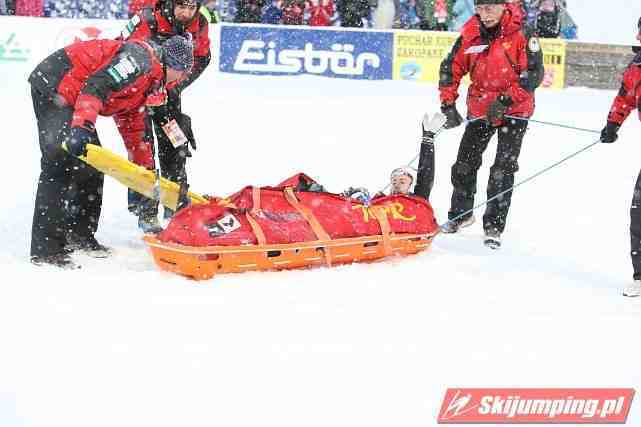For those living in the Northern Nevada area, a strong sense of déjà vu is sweeping the state as residents check their local weather reports. Winter storm warnings were in effect over the past weekend, warning residents to avoid the roads and stay indoors if possible. While this may feel like a story we all expect to hear in late January, few Nevadans expect to be skiing fresh powder on Memorial Day. But with the official start of summertime fun just days away, a winter wonderland is prevailing in the Reno-Tahoe area. Although this development is a boon for the region’s ski resorts and the thousands of skiers young and old who flock to them – and especially for those season-pass holders, who are getting more than their money’s worth – it is also a harbinger of more injuries to come.
The winter storm that swept the region sweeping the region dropped around a foot of snow above 6,000 feet of elevation in the Sierra Nevada Mountains, and rain showers were predicted throughout the greater Northern Nevada and Northern California region. Meteorologists expected rain and snow to continue off and on through the week, making the stormy Sierras part of a larger trend of late-May snow throughout the western United States. [1] Some highways throughout California and Nevada were closed by transportation authorities, and many residents in the region were left briefly without power. On the outskirts of this storm, in areas near Fresno, California, hail and thunder were expected. Predictions included the possibility that funnel clouds might form as winds gusted toward the foothills of the Sierra Nevada range. [2] More of the same is possible as the Memorial Day weekend begins. [3]
This year has brought an unusually large amount of snow to the Sierra Nevada Mountains. As of Sunday of last week, the Squaw Valley ski resort had received a total of 704 inches of snow (almost sixty feet) for the 2018-2019 skiing season. As of the same date in the year of 2018, the region had received only 411 inches of snow, less than three-fifths of what has been seen so far. On the other hand, the same period in 2017 saw even more precipitation, with 724 inches of snow accumulated by May 17.
Meteorologists claim that the latest series of storms is due to a phenomenon called “atmospheric rivers.” This is the result of a strong jet stream heading south over the western United States, bringing cold air from the north and storms from the Pacific Ocean. [4]
All this snow means that many ski resorts in the greater Reno-Tahoe region will stay open at least through the coming Memorial Day weekend. Heavenly ski resort will stay open through May 27 this year; Squaw Valley will remain open daily until May 27, but it will continue to open every weekend until the Fourth of July weekend, with its planned last day of operation being July 7. Let freedom ring – and ski! (Too bad for Alpine Meadows, which ended its season this past Sunday, May 19.) [5]
The region’s ski enthusiasts – the weekend warriors and self-proclaimed ski bums alike – are “stoked” for even more weeks of fresh powder. However, with an extended ski season comes an extended risk of athletic injury. Skiing and snowboarding are thrilling sports, but they come with an extreme risk of accident and injury. Every year, roughly 40 people die in skiing and snowboarding accidents in the United States. The majority of these fatalities were men, and they were more likely to be skiers than snowboarders. There are also roughly 45 serious injuries per year resulting from skiing and snowboarding accidents. (According to the report, a serious injury refers to paralysis, serious head injury, or other serious injury.) Again, the injuries are more likely to accrue to men and to skiers. It goes without saying that, with more days of skiing available to Nevada residents, we are likely to see more serious accidents on the slopes. [6]
One thing you can do to keep yourself safe wile skiing is to always hit the slopes with a responsible buddy. That way, if someone gets injured, there is always someone who can assess the situation and go for help if necessary. If someone you know is injured while skiing, try not too leave the injured person all alone. Ski trails can be isolated, and leaving someone behind creates a risk that they will not be found. Alternately, then can be busy with other skiers, in which case you want to remain present to make sure others do not collide with the injured person. Try to flag down another skier and ask that person to go for help. All established resorts have a ski patrol with trained staff who is ready to help in injury situations. Do not try to move the injured person, and do not remove their skis. Take off your own skis and stand them upright in an X, which signals that you need help. If the injured person is able to move, have the person move to the side of the run, out of the way of other skiers. Try to keep the skier warm and safe until help arrives. [7]
[1] https://weather.com/photos/news/2019-05-21-late-may-snowfall-rockies-photos
[2] https://www.fresnobee.com/news/weather/article230588879.html
[5] https://abc7news.com/weather/more-snow-means-more-tahoe-skiing/5302647
[6] https://www.nsaa.org/media/68045/NSAA-Facts-About-Skiing-Snowboarding-Safety-10-1-12.pdf
[7] https://www.travellingking.com/injured-while-skiing-or-snowboarding



